How the Red Army was preparing for the battle for Berlin
The strategic plan of the Supreme Command Headquarters to end the war took shape as early as November 1944 and was reflected in the strategic plan of the winter campaign 1945. The final stage of the war was planned to be carried out in two stages. At the first stage, the Red Army was to defeat strategic enemy groups in East Prussia, Poland, Slovakia and Hungary, and reach the line Bromberg, Poznan, Breslau, Vienna, creating favorable conditions for the complete defeat of the Wehrmacht and the final Berlin strategic operation. At the second stage, they planned to take Berlin, go to the Elbe and end the war. The Berlin Front should have taken Berlin on the basis of the November 1944 plan.
The Soviet Stavka could not precisely determine how future events would develop. The victorious development of the Vistula-Oder operation gave hope that the Red Army would continuously and quickly carry out the Berlin operation. However, further events showed that it was impossible to end the war during the winter campaign. The Wehrmacht continued to resist fiercely, continued to redeploy troops to the east due to the weakening of the Western Front and threw the last reserves into battle, put serious counterattacks on strategic flanks - in Eastern Pomerania and Hungary, the Soviet troops needed time to prepare for a rush to Berlin.
The troops of the 1st Belorussian and 1st Ukrainian Fronts in the previous heavy battles suffered heavy losses, there were 4-5 thousand people in divisions. The rapid advance of the troops led to the rear being behind, communications were greatly stretched. Railways needed to be redone on the Russian rut. The troops lacked fuel, ammunition, spare parts for equipment, and many others. friend. The artillery did not have ammunition for normal artillery preparation, which was required to break through the German defense on the Oder. Delayed with relocation aviation, ground troops broke away from the air armies, new airfields near the troops have not yet been prepared. This led to the fact that after the release of our troops to Oder, we temporarily lost air supremacy (!). So, if in the first half of February 1945 the German Air Force made about 1 thousand sorties in the 14st Belorussian Front, then our aviation only 1233 sorties. As a result, due to serious circumstances, they could not take Berlin in February 1945.
In the central (Berlin) direction, Soviet troops reached the distance of a direct strike against Berlin, but the flanks had to solve difficult tasks, destroying powerful strategic groups of the enemy and storming its strongholds. On the northern (right) strategic flank, our troops solved the task of destroying the East Prussian and East Pomeran groups. The 1 Belorussian Front, which had reached the Oder in the center, had to turn part of its troops into the East Pomeranian direction in order to fend off German counterstrikes and help 2 of the Belorussian Front to defeat the Vistula Army Group. The German command hoped to launch a powerful counterattack from the north on the flank and rear of the 1 Belorussian Front, using the Pomeranian bridgehead, destroying part of the Soviet troops, and restoring the defense line on the Vistula. However, the successful actions of the Soviet troops thwarted enemy designs.
On the southern (left) strategic flank heavy fighting went on in Hungary. The Germans fought fiercely and tried to throw our troops into the Danube. In February and March, 1945 was under heavy fighting in the Budapest direction, near Lake Balaton. The Wehrmacht organized a strong counter-offensive in Hungary, hoping to throw the Soviet troops across the Danube, thereby eliminating the threat to Vienna and the southern regions of Germany. The German High Command wanted to keep the last sources of oil in Hungary and Austria. However, on the southern strategic flank, the Red Army won up. Budapest, Bratislava, Vienna and Brno were taken. Germany has lost the latest sources of oil and large industrial areas. The serious losses of the Wehrmacht’s southern strategic group did not allow it to influence the development of events in the central (Berlin) sector.
Given this, the Soviet General Headquarters, the General Staff and the front command came to the conclusion that it was necessary to postpone the final operation of the Great Patriotic War to a later date. It was necessary to solve the tasks of crushing the enemy’s strategic groupings on the flanks, replenishing the troops with personnel, material and technical means, restoring air supremacy and regrouping the troops. Offensive moved to the spring of 1945.
At the same time, the General Staff and the front command continued work on the preparation of the plan for the Berlin operation. So, for example, at the end of March 1945, the command of the 1-th Belarusian Front presented the General Staff with two options for the operation: Plan "A" and Plan "B". According to the first variant, they planned to launch an offensive from that line and those bridgeheads that the Soviet troops occupied by that time, with the main strike launched from the Kustrin bridgehead. According to plan “B”, at first they were going to conduct a series of private operations to improve the position of the front before the decisive operation. They planned to carry out an operation to seize a new bridgehead south of Schwedt, and to significantly expand the Frankfurt bridgehead. The main blow to the plan "B" planned to inflict on the Frankfurt direction.
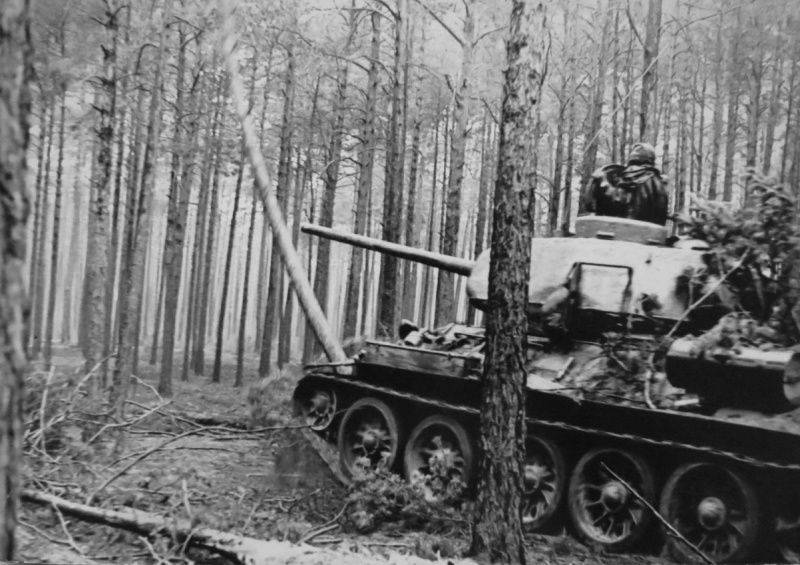
Soviet tank T-34-85 in the pine forest south of Berlin
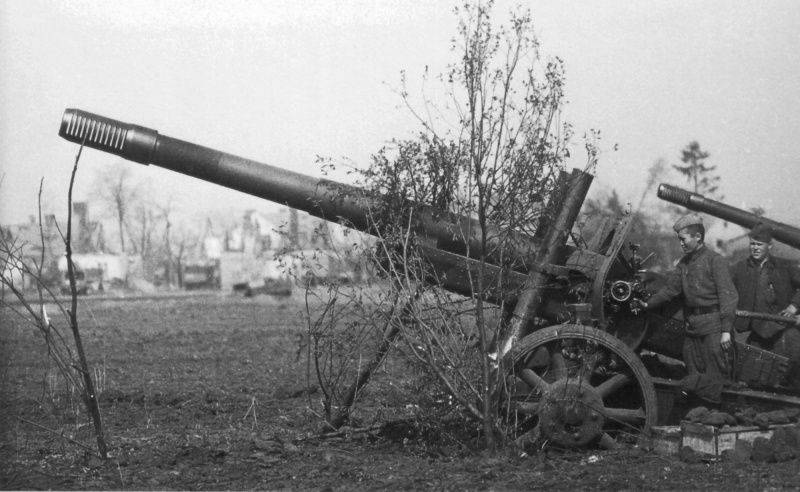
Battery 152-mm howitzers ML-20 1 of the Belarusian Front on the position on the outskirts of Berlin
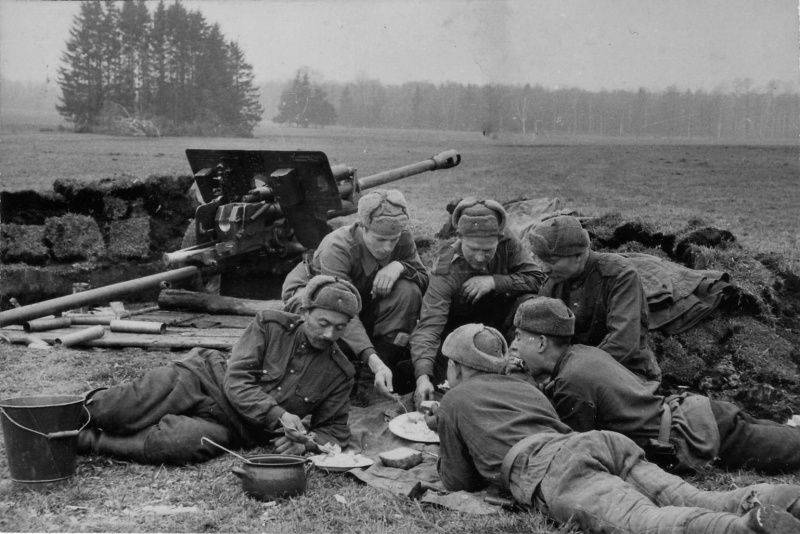
Calculation of Sergeant Trifonov's 76-mm guns at lunch on the outskirts of Berlin
31 March 1945 The General Staff and the front commanders reviewed the overall design of the operation. There is only one question left - the demarcation line between the Belarusian 1 and the Ukrainian 1 fronts. Previously, the boundary line was south of Berlin, the German capital had to take the troops of Zhukov. However, the commander of the Ukrainian Front 1, Konev, did not agree. He believed that his troops should be able to strike at Berlin from the south-east or south.
On April 1, a meeting of the Headquarters took place, dedicated to the Berlin operation. Supreme Commander-in-Chief Joseph Stalin assessed the military-political situation in the theaters of war and pointed out the need to resolve the Berlin problem as soon as possible. The operation had to start no later than April 16 and complete in 12-15 days. Then the head of the General Staff, Antonov, was heard, who announced the preliminary plan. Stalin solved the problem of the demarcation line. On the map, he crossed out that part of the demarcation line that separated Konev's troops from Berlin, keeping it only up to the city of Lubben (60 km southeast of the capital). "Whoever breaks in first," Stalin said, "let him take Berlin." The command of the 1st Ukrainian Front was instructed to develop an action plan for the 3rd and 4th Guards tank armies when they, after breaking through the Neissen line, will attack Berlin from the south. On April 2 and 3, the Stavka gave the fronts a directive to immediately begin the direct preparation of the operation.
Due to the fact that the troops of the 2 of the Byelorussian Front at that time were still fighting to eliminate the remnants of the East Pomeranian group in the area of Danzig and Gdynia, the Rokossovsky commander did not attend this meeting. He was tasked in writing. 1 April The headquarters ordered the 2 of the Belarusian Front to urgently regroup the main forces (three armies, several tank and mechanized corps) into the Stätta direction in order to change the troops of the Belarusian Front 1.
The general idea of the Soviet Stavka was as follows: three fronts with six powerful blows were to break through the enemy defenses in the sector from Stettin to Pensch, dismember the Berlin group of the Wehrmacht into parts, destroy them and take Berlin. On the 12-15 day of the offensive, our troops were to go to the Elbe and join up with the allies. The preparation of the operation took 12-14 days. It was impossible to delay the operation, as there were negative scenarios for the development of the situation associated with the policies of the leadership of the Third Reich and part of the Anglo-Saxon elite.
The headquarters set the following tasks for the fronts. Zhukov’s troops were to crush the German defense on the 90-kilometer stretch between the Hohenzollern and Oder-Spree canals in three simultaneous attacks, crush the main forces of the 9 Army on the outskirts of Berlin, take the German capital by storm and 12-15 to attack the Elbe on the day of attack ( Labe).
The main strike force of the 1 Belorussian Front, consisting of 4 combined-arms and 2 tank armies, struck from a bridgehead on the western bank of the Oder River in the Kustrin region. The mobile units, after breaking through the Oder defense line, were to go around the German capital from the northeast and north. To develop the success of the shock group was to be another combined army, which constituted the second echelon of the front. To ensure the success of the main attack force, they planned to deliver two auxiliary strikes on the flanks with two combined-arms armies each: the first from the Berwalde district in the general direction of Eberswalde-Ferbelin; the second blow - from the bridgeheads to the south and north of Frankfurt an der Oder in the general direction on Fürstenwalde - Potsdam - Brandenburg.
As a result of the right-flank auxiliary strike, the main strike force was provided from a possible counterblow from the north, Berlin was swept from the north, creating an outer ring of the environment. The southern auxiliary strike led to a bypass of Berlin from the south; the Frankfurt-Guben group was cut off from the German capital, which facilitated the defeat of the Berlin group's core.
In order to strengthen the power of the strike of the 1 of the Belorussian Front, the Stavka directed the 3 Army of General Army, the 8 breakthrough artillery divisions and a number of other units and formations to reinforce it. Given that the Belarusian Front 1 was assigned the main role in the operation, its lane was narrowed to 175 km due to the transfer of the section from Kolberg to Schwedt to the armies of the Belarusian Front. The boundary line with 2 BF passed through Pyritz, Schwedt, Angermünde, Gransee and Wittenberg.
1-th Ukrainian front was to break through the German defensive line on the river. Neisse, quickly defeat the main forces of the German 4 Tank Army in the Cottbus area and advance in the western and north-western directions, go out to the Elbe. The main strike forces of the five combined-arms and two tank armies planned to inflict from the area of Triebel to Shpremberg. The right wing of the front was to take part in the storming of Berlin. After the capture of Berlin, the troops of the front were to attack Leipzig.
In order to ensure the success of the main strike grouping of the front from the south, where the enemy’s counterstrike was possible, two combined-arms armies had to advance in the Dresden sector. The troops of the front left wing remained on the defensive, paying special attention to the Breslavl line. The boundary line between 1 BF and 1 UV passed through Gros-Gastrosa and Lübben.
In order to strengthen the strike force of the main front grouping, the Supreme Command transferred the 1 and 28 army from the 31 Belorussian Front to the 3 of the Ukrainian Front. The 31 Army arrived on April 21 and was used on the left wing of the front, while the Army 28 took part in the battle as it stayed on April 21. Front also handed 7 artillery division breakthrough.
The commander of the 2 Belorussian Front, Rokossovsky, received an order to occupy a section of the front from Kohlberg to Schwedt, replacing the troops of the 1 BF. The front troops were to advance in the general direction of Stettin - Rostock. The troops of 2 BF were given the task of breaking the enemy’s defenses in the area between Shvedt and Stettin, defeating the enemy’s 3 Tank Army, and did not allow it to retreat to Berlin, thereby ensuring the advance of the 1 BF from the north. Then the Soviet troops were to develop an offensive in the western and north-western directions, and on the 12-15 day of the operation reach the line Anklam, Demmin, Varen and Wittenberg. The main shock grouping of the front struck with the forces of three combined-arms armies, three tank and 1 mechanized corps from the area north of Schwedt to Neustrelitz.
Thus, according to the Supreme Command headquarters, three Soviet fronts were to inflict six powerful blows on the enemy, destroy the Oder-Neissen defensive line, dismember and destroy the Berlin grouping, take Berlin.
The maneuver of the right-flank formations of the shock grouping of the 1 of the Belarusian Front, bypassing the German capital from the north and northwest, and the right-flank connections of the 1 of the Ukrainian front, bypassing the city from the south and south-west, was to lead to the encirclement of troops defending directly on the Berlin direction (9 th and 4 th tank armies). At the same time, the impact of the left flank of the 1 of the Belarusian Front in the general direction to the southern outskirts of Berlin and Brandenburg dissected the entire Berlin group into two parts. All this facilitated the capture of Berlin, since the main forces of the 9 and 4 tank armies fell into the “cauldron” southeast of Berlin and could not take part in the decisive battles for the German capital.
The development of the attack group of the 2 of the Byelorussian Front to the west and north-west led to the defeat of the German group north of Berlin (3-I tank army). German troops, located north of the Hohenzollern and Finov canals, were cut off from Berlin, unable to maintain the garrison of the capital, pressed against the sea and destroyed.
preliminaries
The troops of 2 of the Byelorussian Front, which had just completed the East Pomeranian operation, in the period from 4 to 15 of April, regrouped from the cities of Danzig and Gdynia to the line of the Oder river, replacing the army of 1 of the BF. The railways, which were destroyed by the Germans, and the acute shortage of rolling stock did not allow for the transfer of troops by train. The main burden was laid on vehicles, part of the way the army overcame on foot. In total, the troops of the 2 BF Front overcame 350 km. "It was a difficult maneuver of the troops of the whole front," Marshal K. K. Rokossovsky, the com-front, noted, "which was not like this throughout the entire Great Patriotic War."
Aviation has done a great deal of aerial reconnaissance. The aircraft made about 15 thousands of aerial photographs of the Oder-Neisen defensive line and the Berlin defensive area. According to air and military intelligence, detailed diagrams, plans, maps were drawn up with which the headquarters of all levels supplied. The headquarters of 1 BF created an exact layout of Berlin with the suburbs to work out the organization of the assault on the city. A few days before the start of the operation, Soviet troops conducted reconnaissance in force in order to identify the enemy’s leading edge, its firing positions, and identify the strengths and weaknesses of the German defense.
The engineering troops performed a huge amount of engineering work. The engineers of the 1 BF even before the start of the operation built 25 bridges over the Oder and prepared 40 ferry crossings. In order to ensure the uninterrupted supply of troops, the engineering troops overtook the railways to the Russian track almost to the Oder. In addition, great work was carried out to strengthen the bridges over the Vistula, which were under threat again during the spring ice drift. The engineering troops of the 2-Byelorussian and 1-th Ukrainian Fronts did a great deal of work to prepare the floating craft for forcing the Oder with sleeves and Neisse. Gaties were carried out on the wetlands, berths were prepared, materials were prepared for the construction of bridges, etc.
The Soviet command knew that the enemy was aware of the impending attack on Berlin, so special attention was paid to the questions of camouflage and the achievement of operational and tactical surprise. The command of the 2 of the Byelorussian Front simulated the preparation of an offensive on the Stätta sector. The 1 Belorussian Front defiantly prepared an offensive in the Guben area. At the same time, in the Küstrin-Berlin sector, where the troops of Zhukov were supposed to deliver the main attack, active engineering defensive works continued. Especially diligently such work was carried out in areas that are well viewed by the enemy. They tried to convince the Germans that in this sector of the front the Red Army was preparing for defense. To avoid information leaks, the personnel explained that the main task at the present stage is stubborn defense. In addition, the Germans were thrown misinforming documents that weaken their attention in the area of the front where the armies of the 1 of the Byelorussian Front planned to deliver the main attack.
The arrival of replenishments, reserves, and new connections was carefully concealed. Military trains were disguised as trains that carried timber, hay, etc. The circle of fully knowledgeable persons was extremely narrow. In addition to the command of the front, the commanders of the armies, the chiefs of the army headquarters, the chiefs of the operational divisions of the headquarters of the armies and the artillery commanders familiarized with the directives. The regimental commanders received offensive tasks only three days before the offensive, and junior commanders and privates learned about the offensive only two hours before the operation.
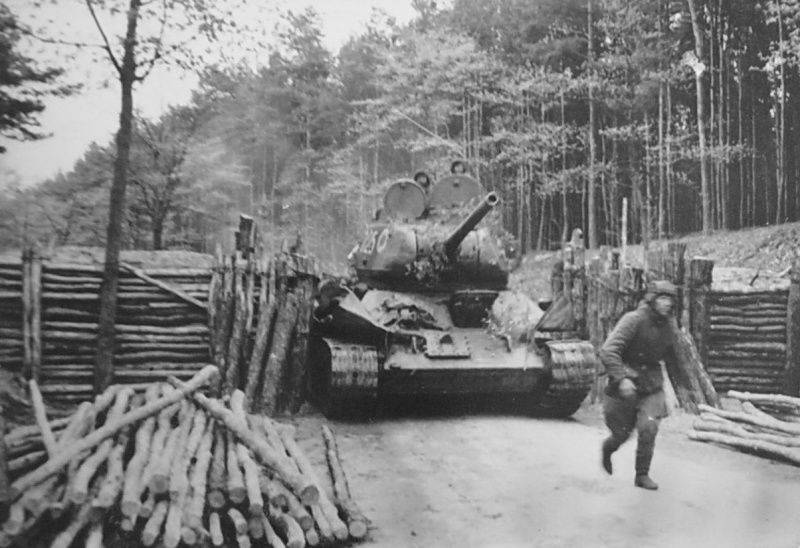
Tank T-34-85 7 Guards Tank Corps on the road on the outskirts of Berlin
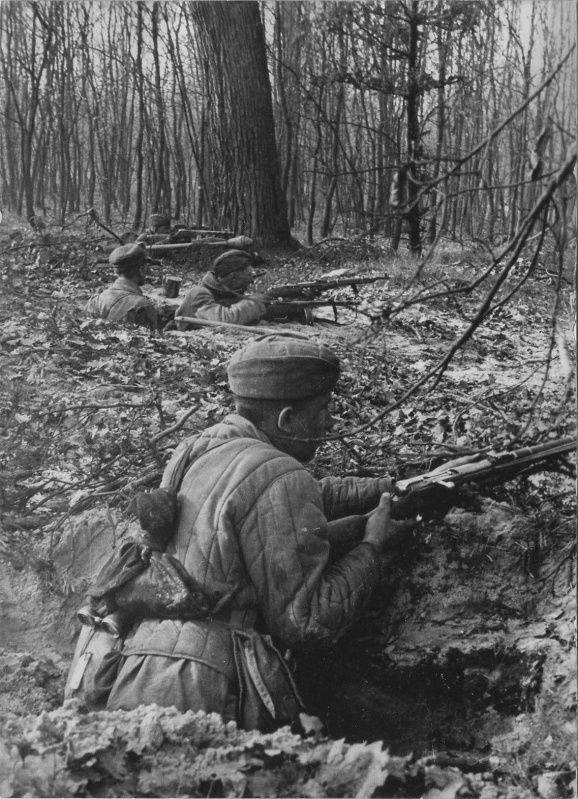
Soviet soldiers in the trenches on the outskirts of Berlin. In the background is seen the captured German grenade launcher "Panzerfaust"
To be continued ...
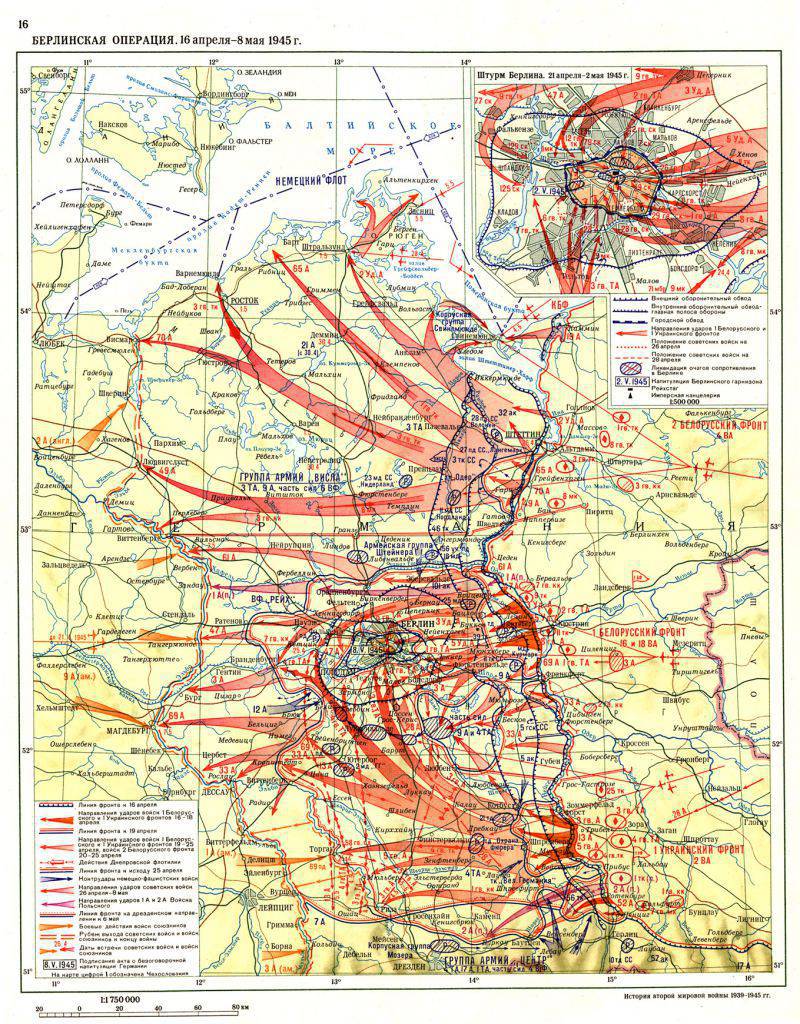
Information